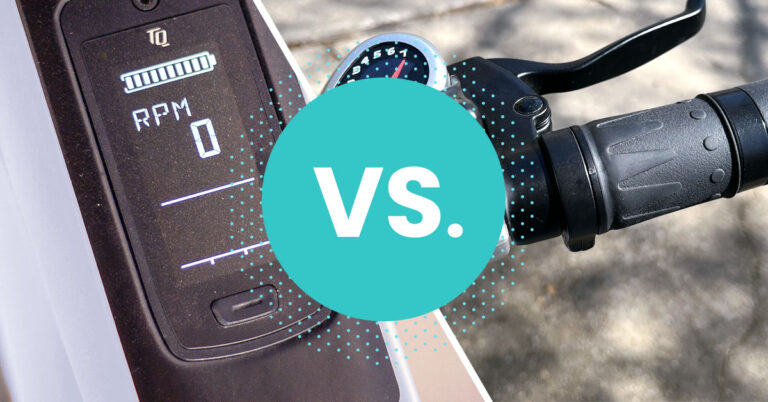Looking into the world of electric bikes, you will run into lots of jargon and technology that has come about with the emergence of these relatively new additions to the cycling world. With throttles effectively illegal in Europe and the UK, in the US you will see that some bikes have pedal assist (PAS), some have throttles, and some have both. What do these mean and why are they relevant to cycling?
Pedal Assist and Throttle: Three-Class E-Bike System
Pedal Assist, shortened to PAS, is a technology where the motor adds power when you turn the pedals. This differs from a throttle, which involves using a button, lever, or half-twist throttle like those on a motorbike to adjust the power input from the motor.
In Europe and the UK, throttles are largely illegal, but here in the US, they are sometimes permitted based on a confusing set of individual state laws on electric bikes. If you want to know the law on e-bikes in your state, visit this helpful article by the National Conference of State Legislatures here.
As you will see, 39 states have legislation recognizing three classes of e-bikes. These are:
- Class 1: The bike is pedal assist only and the motor will cut out at 20 mph.
- Class 2: The bike has a throttle that will cut out at 20 mph. It can also have a pedal assist function.
- Class 3: The bike is pedal assist only and the motor will cut out at 28 mph. It is also equipped with a speedometer
Notably, some electric bikes can be considered “out of class.” Any e-bike beyond 750 watts of power is technically not an e-bike at all, although some states allow e-bikes to reach up to 1000 watts of power. Some electric bike companies also make e-bikes that essentially combine Class 2 and Class 3 into a single bike, making them out of class.
The article on state laws above shows that some states permit electric bikes in some places but not in others, with forbidden zones including state parks. Once more, six states — Alabama, Alaska, Massachusetts, Missouri, New Mexico, and North Dakota — require a license to operate an e-bike. Given that two other states have recently dropped this requirement, it is likely that the six listed will do so in time. You can read more about the e-bike state laws.
What is Throttle Mode and How Does It Work?
A throttle is where you press a button or lever or turn a half-twist handlebar throttle to switch on the motor. Button throttles, on the very cheapest electric bikes, are either on or off, so you cannot adjust the power on the bike. Hand throttle/twist throttles allow you to adjust the current to the motor and therefore how fast you go.
Why is Throttle Mode Beneficial?
Throttles are part of the reason the electric bike market has been so successful in the US. They allow you to simply sit on the bike and go where you want to without any physical exertion.
If you are returning to cycling due to injury or ill health, you will appreciate having the option to pedal or not. This could mean simply getting some fresh air while letting the bike do all the work. On the other hand, at the end of a long ride using PAS, using a throttle will allow you to rest your legs so you don’t put too much pressure on your cardiovascular system or any injury.
With quick acceleration, a throttle can enable you to pull away more quickly into traffic, get ahead of other vehicles, and thereby be safer than if you pedal when pulling away on some types of e-bikes.
Finally, not everyone wants to be sweaty when they get to their destination, such as a business meeting or job interview. The throttle can allow you to get where you’re going without looking like a mess!
What is Pedal Assist and How Does It Work?
Pedal Assist (sometimes referred to as PAS) is where the motor switches on when you turn the pedals. This is another reason that e-bike sales have boomed — even older and less abled riders can pedal up a steep hill without wondering if they’ll make it to the top.
Essentially, a PAS has sensors that measure when or how hard the rider is pedaling. It feeds power into the drivetrain so you get an invisible push. On-board computers have pedal assist levels that allow you to decide how much power the motor should add to your riding:
- Level 1: (Eco Mode) This mode offers the least amount of power.
- Levels 1-3: These mid-range modes will help a little more on more difficult terrain.
- Level 5: (Turbo Mode) Those modes will give you the maximum power, perhaps on a tough climb.
Each of these pedal assist levels will drain the battery at different rates — but using a throttle alone, without pedaling, will exhaust battery life rapidly. As with many e-bike riders, you might become a bit of a nerd about this, geeking out on how little battery you have used after a particular ride.
Torque- vs Cadence-Sensing Systems
Within the general term ‘pedal assist’, there are two broad types of sensors that measure pedaling: cadence and torque sensors.
On less expensive e-bikes like some made by Himiway, a cadence sensor will measure whether you are pedaling, but that’s it. Up to 12 sensors around the pedal crank will assess whether there is movement and switch on the motor. This can cause a delay of a second or two between you pushing the pedal and the motor kicking in, making for a jerky, unnatural feel.
More premium brands like Trek have long since dumped the cadence sensor and gone over to the torque sensor. These sensors come in a variety of types but all attempt to measure the amount of force put on the pedals, with the onboard computer responding by offering a measured amount of energy from the motor. This provides a far more natural and instant feeling of power, and it can prevent wheel spin should you have the PAS mode too high when you pull away.
PAS vs Throttle Mode: Which is Better?
There is no ‘right’ answer to this as both modes have their benefits and drawbacks. There is even a bit of passion and back and forth between brands and experts regarding this argument, with Trek and other e-bike manufacturers branding throttles as unsafe.
For a more natural riding experience, an electric bike with a torque-sensor PAS system will always be the winner. On quality electric bikes, it feels like your leg muscles are twice their size and you can get up even the steepest climbs without breathing much harder.
A PAS/throttle system will offer the best of both worlds: Do you want to pedal with support or just sit back and enjoy the ride? This is a particularly good combination if you have health concerns and want to ease into cycling gently, as having a quality throttle will enable you to pedal when you want and still get about when you don’t want to exert yourself.
It is interesting to note that the more premium electric brands, often with footprints in the UK and Europe, seem to shun throttles altogether. Whether this is due to manufacturing issues or their politics (as shown by Trek), is up for debate. This does open up the market to lower-cost brands like Himiway, Rad Power, and Pedego that offer the throttle option on many of their models.
Ultimately, it may be a matter of personal preference. With these ideas to consider, you can make a better decision as to what sort of electric bike you want to have: a premium European-style pedelec or a throttle-assist American cruiser.

